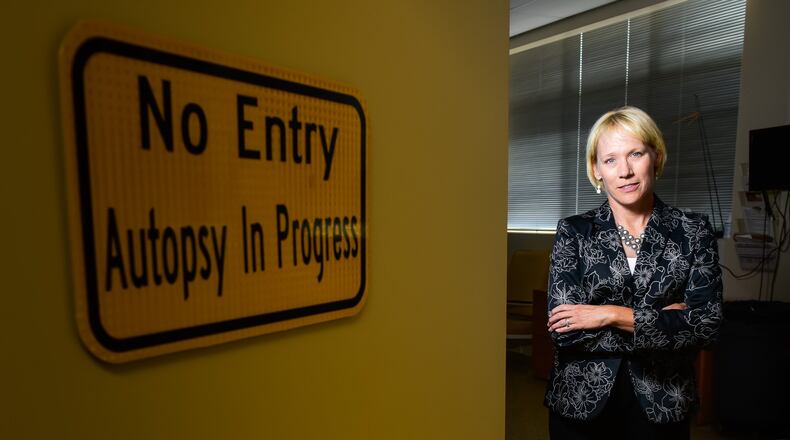Take toxicology testing, which every overdose death requires to determine the exact cause of death. The office spent just shy of $30,000 on those tests through June, compared to $37,723 for all of 2014. Nearly daily a new strain of the drugs are infiltrating the county and that requires more testing, according to coroner’s office administrator Martin Schneider.
“While the cost of the individual tests with our lab has remained consistent, the drugs coming into Butler County are certainly not,” Schneider said. “Newer and never before seen fentanyl analogs create the need for additional tests and as our number of overdose deaths increase, so too do our toxicology costs.”
Mannix said there are basic tests for typical overdose drugs — that can cost in the range of $100-$200 — but the new drugs coming in don’t register on the regular screening panel so they need to go to the next level — double the original price.
But it’s not just testing that is taxing the coroner’s office budget. Overtime costs for investigators have risen in the past couple years. Schneider said overtime for the investigators — one must be on-call 24/7 — warranted adding a fourth person.
“In 2008 we had 300, roughly, cases and last year we had 485 cases,” Schneider said. “When you count in the number of hours to work that case, when we were at only three investigators and wanted to add a fourth, I calculated how much overtime the three collectively were earning and in a pay period they were earning better than 30 hours and that’s a full-time position right there.”
The coroner’s office handled 72 overdose deaths in 2008; 118 in 2013; and 232 last year. The office had 485 total cases last year.
The coroner’s total budget has increased 34 percent between 2012 and last year. The actual budget in 2012 was $875,470, according to the auditor’s comprehensive annual report and $1.2 million last year.
“I always feel our statistics are very objective, in terms of I can tell you the number of people that die,” Mannix said. “When you push that back out we’re kind of the inverted pyramid. We get the deaths, but for every death how many police, EMS, all these other services that may or may not be directly related, the theft, they are stealing to buy drugs, so it all funnels down into it.”
Many other county departments are also feeling the epidemic’s pinch, including the Butler County Mental Health and Addiction Recovery Services Board, which has had to ramp up its attack on the opioid epidemic as well, to the tune of $3.6 million a year.
Only recently has the MHARS board culled almost full funding for the plan. Executive Director Scott Rasmus said a mix of newly approved mental health levy dollars, state, federal and Medicaid dollars are all being used to fund the fight.
“For most of it we do have sources but there are still some aspects of it we need additional money,” Rasmus told the Journal-News recently.
The opioid plan is a multi-pronged attack that includes detox services, recovery housing, Narcan kits for family and friends, additional residential treatment beds and prevention education.
The county also resurrected the Family Treatment Drug Court, to help addicts who have lost custody of their kids recover from their addictions and families reunite. That program restarted, after a five-year hiatus when funding fizzled, last summer. Their docket has doubled and eventually could help 45 to 60 clients at a time work to get clean.
The county commissioners approved the program, even before a $2.1 million federal grant came through. Commissioner Don Dixon said it is imperative everyone countywide joins the battle.
“We’re going to have to continue to come up with innovative ways to deal with it. It kind of leaves you no alternative…, Dixon said adding that everyone from the coroner, sheriff, courts, MHARS and others are doing a stellar job of finding ways to deal with the problem. “We try to make it work, we have to make it work.”
Outside funding has been critical to these efforts and Mannix’s office received a boost, along with all state coroners recently when the state allotted $1 million to help with the overdose eruption statewide. Mannix said “unfortunately Butler County gets a lion’s share of that because of the number of overdose deaths” here. It amounts to about $14,000 a quarter which covers maybe five to 10 cases and they’ve been getting about five a week.
The budgetary concerns are not the only toll on Mannix’s office either.
“Every death is a family that’s lost somebody,” Mannix said. “A lot of times that’s been a long struggle. They’ve had a long history of addiction. These families have tried to help them and so there’s a sense, when they lose this battle, of failure and loss and they’ve tried and all kinds of emotions that we deal with with these families.”
About the Author
